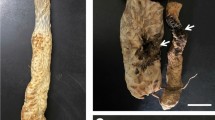Abstract
Flusulfamide (2′, 4-dichloro-α,α,α-trifluoro-4′-nitro-m-toluenesulfonanilide) was investigated for its mode of action against Plasmodiophora brassicae Woronin. Seedlings of Chinese cabbage (Brassica rapa L. subsp. pekinensis) were grown for 14 and 21 days in soil infested with P. brassicae and then transplanted into soil containing flusulfamide (0.9 µg a.i. g−1 dry soil). Clubroot was not suppressed by this treatment, indicating that the fungicide is ineffective against P. brassicae established within cortical cells of the host root. Where seedlings were grown in soil infested with resting spores which had previously been treated with flusulfamide, root-hair infection and club formation were suppressed. This indicates that flusulfamide directly acts against resting spores. When placed in root exudates of Chinese cabbage, untreated resting spores germinated at a high frequency while flusulfamide-treated resting spores hardly germinated at all. Use of the Evan's blue staining assay indicated that flusulfamide-treated resting spores remained viable. Flusulfamide was detected by high performance liquid chromatography on resting spores treated with flusulfamide for 30 min. This indicates that the chemical is adsorbed onto resting spores. These results suggest that flusulfamide suppresses clubroot disease by inhibiting germination of P. brassicae resting spores through adsorption onto their cell walls.
Similar content being viewed by others
References
Akanuma R, Shimizu S and Sekiguchi A (1983) Practical studies on the integrated control for clubroot disease of Chinese cabbage in high altitude cool region. V. Chemical control of Chinese cabbage clubroot disease caused by Plasmodiophora brassicae Woronin. Bull Nagano Veg & Ornam Crops Exp Sta Japan 3: 115-122 (in Japanese)
Dixon GR, Doodson JK, Beeney BW, Davies H, Jemmett JL and Moxon RH (1972) Studies of resistance in swede seed stocks to clubroot (Plasmodiophora brassicae). J Natl Inst Agric Bot 12: 456-463
Gaff DF and O'kong'o-ogola O (1971) The use of non-permeating pigments for testing the survival of cells. J Exp Bot 22: 756-758
Inami S, Kijima T, Yanagida H and Emoto Y (1988) MTF-651, a novel fungicide controlling clubroot. Abstr 5th Intr Congr Plant Pathol, Kyoto, p 326
Jacobsen BJ and Williams PH (1970) Control of cabbage clubroot using benomyl fungicide. Plant Dis Repr 54: 456-460
Macfarlane I (1970) Germination of resting spores of Plasmodiophora brassicae. Trans Br mycol Soc 55: 97-112
Naiki T (1985) Mode of action of fungicides on Plasmodiophora brassicae. Kongetsu no Noyaku 29: 33-40 (in Japanese)
Naiki T and Dixon GR (1987) The effects of chemicals on developmental stages of Plasmodiophora brassicae (clubroot). Plant Path 36: 316-327
Newcombe G and Thomas PL (1990) Fungicidal and fungistatic effects of carboxin on Ustilago nuda. Phytopathology 80: 509-512
Samuel G and Garrett SG (1945) The infected root hair count for estimating the activity of Plasmodiophora brassicae Woron. in the soil. Ann Appl Biol 32: 96-101
Seaman WL, Walker JC and Larson RH (1963) A new race of Plasmodiophora brassicae Woron. in the soil. Ann Appl Biol 32: 96-101
Shimotori H, Yanagida H, Enomoto Y, Igarashi K, Yoshinari M and Umemoto M (1996) Evaluation of benzenesulfonanilide derivatives for the control of crucifers clubroot. J Pesticide Sci 21: 31-35
Suzuki K, Matsumiya E, Ueno Y, Mizutani J (1992) Some properties of germination-stimulation factor from plants for resting spores of Plasmodiophora brassicae. Ann Phytopathol Soc Jpn 58: 699-705
Suzuki K, Sugimoto K, Hayashi H and Komyoji T (1995) Biological mode of action of fluazinam, a new fungicide, for Chinese cabbage clubroot. Ann Phytopathol Soc Jpn 61: 395-398 (in Japanese)
Takazawa Y (1993) Development and characteristics of a clubroot-controlling fungicide, Nebijin dust. Noyaku (Agric Chem) 40: 45-51 (in Japanese)
Tanaka S (1996) Recent progress in studies on clubroot disease of crucifers. Shokubutsu Boeki (Plant Protection) 50: 281-284 (in Japanese)
Tanaka S, Katumoto K, Nishi Y and Yanagida (1988) Effect of a new fungicide (MTF-651) to the clubroot fungus. Abstr 5th Intr Congr Plant Pathol, Kyoto, p 326
Tanaka S, Negoro M, Ota T, Katumoto K and Nishi Y (1990) Clubroot of spring Chinese cabbage in Nagasaki Prefecture, Kyushu. Bull Fac Agric Yamaguchi Univ 38: 33-45 (in Japanese)
Tanaka S, Sakamoto Y, Kajima K, Fujieda K, Katumoto K and Nishi Y (1991) Pathogenicity of three isolates of clubroot fungus attacking clubroot-resistant cultivars of Chinese cabbage. Bull Fac Agric Yamaguchi Univ 39: 113-122
Tanaka S, Yoshihara S, Ito S and Kameya-Iwaki M (1997) The influence of virulence of Plasmodiophora brassicae populations on epidemiology of Chinese cabbage clubroot and efficacy of fungicides. Ann Phytopathol Soc Jpn 63: 183-187 (in Japanese)
Taylor JA and West DW (1980) The use of Evan's blue stain to test the survival of plant cells after exposure to high salt and high osmotic pressure. J Exp Botany 31: 571-576
Yoshikawa H, Ashizawa M and Hida K (1981) Studies on the breeding of clubroot-resistance in cole crops. III The ‘insertion’ screening method for clubroot-resistance. Veg & Crop Res Stn Japan A8: 1-21 (in Japanese)
Williams PH (1966) A system for the determination of races of Plasmodiophora brassicae that infect cabbage and rutabaga. Phytopathology 56: 624-626
Author information
Authors and Affiliations
Rights and permissions
About this article
Cite this article
Tanaka, S., Kochi, Si., Kunita, H. et al. Biological Mode of Action of the Fungicide, Flusulfamide, Against Plasmodiophora brassicae (clubroot). European Journal of Plant Pathology 105, 577–584 (1999). https://doi.org/10.1023/A:1008722005570
Issue Date:
DOI: https://doi.org/10.1023/A:1008722005570




